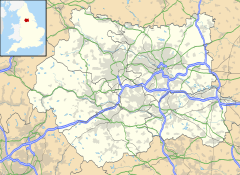Walton, Wakefield facts for kids
Quick facts for kids Walton |
|
|---|---|
 Walton Hall, Walton |
|
| Population | 3,231 (2011 census) |
| OS grid reference | SE357171 |
| Civil parish |
|
| Metropolitan borough | |
| Metropolitan county | |
| Region | |
| Country | England |
| Sovereign state | United Kingdom |
| Post town | WAKEFIELD |
| Postcode district | WF2 |
| Police | West Yorkshire |
| Fire | West Yorkshire |
| Ambulance | Yorkshire |
| EU Parliament | Yorkshire and the Humber |
| UK Parliament |
|
Walton is a village and civil parish located in West Yorkshire, England. It's about 4 miles south-east of the city of Wakefield. In 2011, about 3,231 people lived here.
Walton is famous for Walton Hall, which was once the home of a special person named Charles Waterton. He was a naturalist and explorer. In 1820, he turned the land around Walton Hall into the world's first nature reserve! This area is sometimes called Walton Park or Waterton Park.
Today, Walton Hall is a hotel called Waterton Park Hotel. Much of the park is now a golf course, also named Waterton Park. You can still walk through parts of the park on public paths.
Near the village, there's a nature park called Walton Colliery Nature Park. This used to be a coal mine! In the mid-1990s, it was changed into a beautiful park with big lakes. The village also has a small park, a tennis club, football and rugby pitches, a recently updated pub, and a sports and social club.
Contents
What Does the Name Walton Mean?
The village of Walton has a very old name! Around the year 1086, it was written as Waleton in the Domesday Book. But even before that, between 650 and 830, it was known as Weala-tun.
How Did Walton Get Its Name?
The name Weala-tun means 'Welshman's Village'. This suggests that a group of native British people lived here long before the Saxons arrived in the 7th century. Later, during the Norman dynasty, the village was called Waton. But since the Middle Ages, around 1154, it has been known as Walton.
Schools in Walton: A Look Back
Walton has a long history of educating its children. The first village school started in 1722.
How Did the First School Begin?
Charles Waterton, the grandfather of the famous naturalist, gave two large cottages on Shay Lane. One cottage was a small schoolroom. The other was given to the schoolmaster to live in for free. In return, he had to teach two poor children from the village without charging them.
New Schools and Growth
In 1790, a wealthy woman named Catherine Neville left money in her will to start a new, free school in Walton. This school worked alongside other smaller schools in the area.
Later, in 1857, Miss Mary Pilkington paid for a new school building on School Lane. This building also included a house for the schoolmaster and a laundry school. This school taught children until 1911, slowly taking in more students from other village schools until they closed.
The 1857 school building was taken down in 1911. However, a new school for children aged 3 to 11 was built very soon after.
Meeting the Needs of a Growing Village
As more families moved to Walton, the new school quickly became too small. To solve this, a new infant school was built on The Grove. This school taught all the children aged 3 to 8. Children aged 8 to 11 stayed at the original building.
The original 1911 school closed in 2007. The infant school was also taken down to make way for a brand new school. This new school now teaches all the children from both the old infant school and the original school. It also has the new village library inside! The old 1911 school building was finally demolished in 2009.
Churches in the Village
Since the 1800s, Walton has had two main places of worship for its community.
Methodist and St. Paul's Churches
In the 1800s, the Methodist community met in a building on the Balk. In 1856, they built a small chapel on Shay Lane. St. Paul's Church, also on the Balk, was built with money and land given by the Simpson family. It was dedicated to the Bishop of Wakefield. Walton is part of the Church of England Parish of Sandal Magna.
As the village grew, the Methodist church needed more space. In 1896, a bigger chapel was built. This new design included the original building. In 1910, extra rooms for Sunday school were added.
Walton Colliery: A Former Coal Mine
Walton Colliery was a coal mine in the village. Sadly, on April 22, 1959, there was an explosion at the pit that caused the deaths of five men.
The Mine's Closure
The mine closed on December 3, 1979. This meant that 550 local jobs were lost. Many miners were supposed to move to the new Selby Coalfield, but only about half of them did. The others found work at nearby mines like Ackton Hall, Allerton Bywater, and Nostell Collieries. Later, some of these miners also moved to Selby when those pits closed.
Before it closed, Walton Colliery had been saved from closure several times. In 1977, it needed a lot of money to open new mining areas. The Coal Board said no, but Arthur Scargill, a union leader, did not want a mine to close if there was still coal left.
Walton War Memorial
In the middle of the village, where School Lane (B6378) and Shay Lane meet, there is a war memorial. This memorial lists the names of local men from Walton who bravely died while serving in the First and Second World Wars. It helps everyone remember their sacrifice.
See also
 In Spanish: Walton (Wakefield) para niños
In Spanish: Walton (Wakefield) para niños


